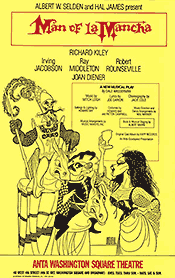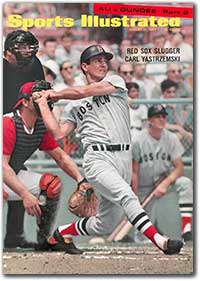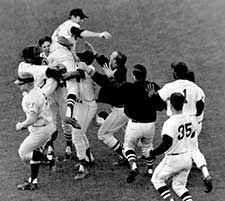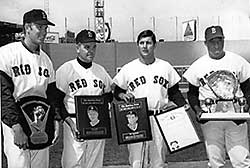The Impossible Dream — 1967 Red Sox Quest for the World Series.

To dream the impossible dream … . Fifty years ago those words immediately brought to mind the hit song1 from The Man of La Mancha, a musical about an elderly knight, Don Quixote, who undertakes noble, but seemingly impossible quests. To baseball fans arriving at Fenway Park in April 1967 the idea of the Red Sox playing in the World Series seemed as unlikely as any of Quixote’s adventures.2
No Matter How Hopeless. The Red Sox of the early 1960s were perennial losers. They lost 90 games in 1966 and hadn’t been to the World Series since 1946. Some games brought fewer than 1,000 fans to Fenway. Red Sox players had a reputation for always being there for last call at watering holes around the American League, and the team often seemed more like a country club where players went to have a good time rather than play serious baseball.
But those who were paying attention sensed change in the air as the 1967 season got underway. Pitching ace Jim Lonborg announced he wanted to win 20 games and play in the World Series. Carl Yastrzemski had been shamed into a rigorous program of off-season conditioning. Several promising young players had joined the team and there was a new, no-nonsense manager, Dick Williams. Williams told players who treated loosing lightly that they would soon have something new to hate — him.
Things got off to a good start — Lonborg led the Sox to a 5–4 win over Chicago on Opening Day. By the end of April the Sox were tied for first place and they remained in the middle of the standings throughout May and into June — a lofty position they hadn’t seen in years.
To Fight the Unbeatable Foe. The first-place Chicago White Sox came to Boston for a three-game series in mid-June. Chicago’s manager, Eddie Stanky, had taunted Yastrzemski by calling him an All-Star from the neck down. Yaz responded with six hits. Passing third base on a homer, he tipped his hat at Stanky in Chicago’s dugout.

Tempers flared as the teams split a double-header; Stanky was ejected and threatening to sue.
The next day the teams met again. The game remained scoreless through ten innings. Then Chicago took the lead in the eleventh and quickly put out Boston’s first two batters. Red Sox fans were starting to leave when third baseman Joe Foy singled.
The team’s fate now rested on the shoulders of a kid from Revere, Tony Conigliaro. He dueled with the pitcher until the count was 3–2. Down to the last strike, Conigliaro homered and the stands erupted. The next day Boston papers referred to the 1967 Red Sox season as the Impossible Dream.
To Reach the Unreachable Star. The heavens seemed to have aligned for Boston. The Red Sox racked up a ten-game winning streak following the All Star break. Fifteen thousand fans greeted them on their return to Logan Airport, more than had turned out for the Beatles the year before. On August 20, Boston came back from an 8–0 deficit to beat the California Angels. By the end of August, Boston was in first place.

September found four teams vying for the pennant. Yastrzemski was on fire, hitting .523 over the final two weeks of the month. Then Chicago was eliminated and, with two days left, the race was down to three: Boston, Detroit and Minnesota. For the Sox to go to the World Series, they had to win both of their games against first place Minnesota and Detroit had to loose at least one.
Boston won its first game against Minnesota and pitching ace Jim Lonborg was scheduled to start the crucial final match. He had never beaten Minnesota; however, and most of his 21 wins had been on the road. So when a friend offered him his room at the Boston Sheraton, Lonborg took it — he figured he would pretend it was an away game.
Minnesota took an early lead. Then the bottom of the sixth opened with a bunt that put Lonborg on first. The next two batters both singled and suddenly the bases were loaded with no outs. Yastrzemski drove in two and the third came home later in the inning. Two more runs and the inning ended with Boston ahead 5–2.
Minnesota rallied in the eighth, but Lonborg held them to one run. Fans burst onto the field when the final out was notched in the ninth.
But the quest was still not ended, for Boston had won its game, but winning the pennant depended on Detroit’s loosing, and they were still alive in the second game of a double header. If Detroit won, the Sox would face them in a one-game playoff.
Red Sox players anxiously huddled around transistor radios in the clubhouse for hours. Champagne corks popped only after Detroit finally lost.
The impossible had happened — the Boston Red Sox were going to the World Series.
* * * * *

Like many Quixotic quests, this one did not end in total victory. The 1967 World Series went seven games, but in the end Saint Louis prevailed. The Sox would have to wait until 2004 to break the fabled curse of the Bambino.
But the 1967 season brought New England baseball back to life. Never again would the Sox languish in the cellar. Jim Lonborg won the year’s Cy Young Award, Yastrzemski batting’s Triple Crown, first baseman George Scott a Gold Glove and Dick Williams, Manager of the Year.
The 1967 baseball season ended with the hearts of Red Sox fans beating proud, for through good times and bad, their team had remained true to its glorious quest. And as Don Quixote says in the song “Impossible Dream,” that’s what really matters.
-----
- You can hear the song sung by Richard Kiley on YouTube. Lyrics are here.
- Information for this article comes from: Glenn Stout and Richard Johnson, Red Sox Century, Chapter on Summer of 67 by Dan Shaughnessy, pp. 315-40, Houghton Mifflin (2005); Mark Mulvoy, Virtue is Rewarded, Sports Illustrated (August 21, 1967); Bill Nowlin, October 1, 1967: Red Sox complete “Impossible Dream,” Society for American Baseball Research web site; Rico Petrocelli and Chaz Scoggins, Tales from the 1967 Red Sox, Skyhorse Publishing, Inc. (2017); and baseball-reference.com for game statistics.
- Poster for Man of La Mancha. Image from Broadway Musical Time Machine: Looking Back at Man of La Mancha.
- Cover of Sports Illustrated for August 21, 1967, available on-line at Sports Illustrated Vault.
- AP Photo. Image from WBUR web site.
- Image from Boston Herald, July 8, 2011.
This article originally appeared in our free semi-monthly newsletter. To receive future issues, please add your name to the subscription list.

